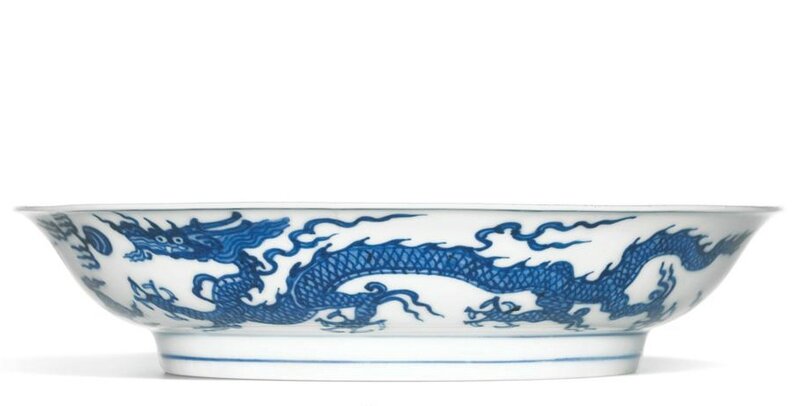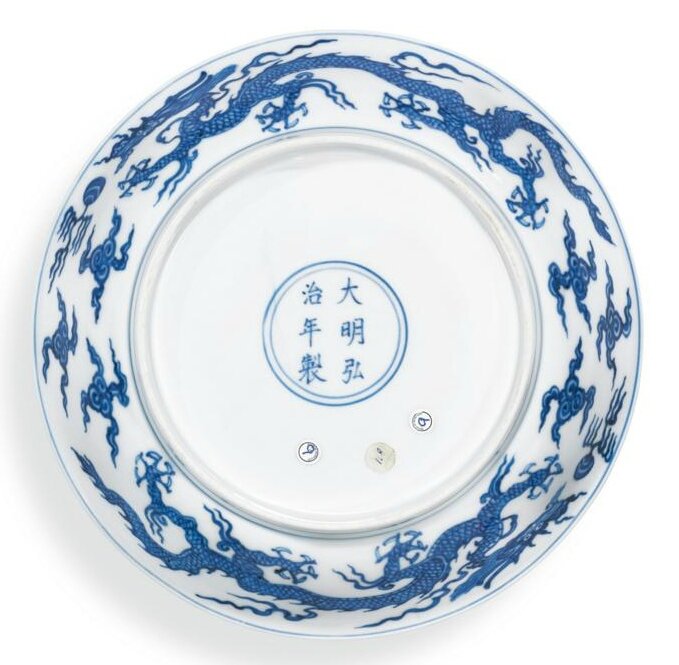![An important and rare blue and white ‘Palace Bowl’, Mark and period of Chenghua]()
![2]()
![3]()
![4]()
Lot 25. An important and rare blue and white ‘Palace Bowl’, Mark and period of Chenghua. Estimate 50,000,000 — 70,000,000 HKD (5,847,154 - 8,186,015 EUR). Photo Sotheby's.
exquisitely potted with smooth rounded sides, gracefully rising from a tapered foot to a slightly flared rim, finely painted in muted washes of cobalt-blue accented with sharp outlines of a deeper hue, the exterior with three large clusters of plump ripe melon vine, all differently rendered with seven or eight fruits, the thin curling tendrils counterbalanced by the thick broad leaves, framed by double-line borders at the rim and foot, the interior left undecorated, thinly veiled overall in a most sensual unctuous glaze, the base inscribed with a six-character reign mark within a double circle - 15.4cm, 6 1/8 in.
Provenance: Collection of H.R.N. Norton (d. 1961/62), until 1936.
Bluett & Sons Ltd, London, 1936 (£35).
Collection of Victor Rienaecker, from 1936 to 1937 (£52:10).
Bluett & Sons Ltd, London, 1937 (£52:10).
Collection of F. Howard Paget (1866-1945), from 1937 to 1945 (£52:10).
Bluett & Sons Ltd, London, 1945 (£30).
Collection of Herschel V. Johnson (1894-1966), from 1945 to 1967 (£52:10).
Sotheby's London, 21st February 1967, lot 38 (£5000).
Bluett & Sons Ltd, London, 1967 (£5000).
Collection of Roger Pilkington (1928-69), from 1967 (£5000).
Bibliography: Adrian Joseph, Ming Porcelains: Their Origins and Development, London, 1971, front cover and pl. 38.
The F. Howard Paget ‘Palace Bowl’
The calm beauty radiating from a ‘palace bowl’ derives from an aesthetic excellence reached at the imperial kilns in the Chenghua reign (1465-87) that has never been equalled again to the present day. There can hardly be a more iconic piece of Chinese blue-and-white porcelain than a Chenghua ‘palace bowl’. Chenghua porcelains are the rarest Chinese imperial porcelains. The wares we today associate most intimately with the Chenghua reign – ‘palace bowls’ and ‘chicken cups’ – represent only a short fleeting moment in the history of Chinese porcelain, yet they left an eternal legacy. ‘Palace bowls’ are the pride or else the desideratum of any museum or private collection of Chinese ceramics. Only one dozen ‘melon palace bowls’ appear to be preserved, including the present piece, but the present bowl represents an apparently unique version of the design, depicting twenty-two melons instead of the usual sixteen, and is painted in a very different style, with fruits and leaves more densely concentrated than on other examples.
The term ‘palace bowl’ designates blue-and-white bowls, probably used at the imperial court for food, made for less than a decade around the 1480s, of unsurpassed material quality and workmanship, unrivalled tactility, unsurpassable proportions, and unobtrusive yet sophisticated designs executed in an irresistibly captivating, complex and yet free and easy painting manner.
Only some two dozen porcelains of Chenghua mark and period of any style or design have been recorded by Julian Thompson as remaining in private hands (The Emperor’s broken china. Reconstructing Chenghua porcelain, London, 1995, pp. 116-29). This rarity of surviving examples is mirrored by the relative scarcity of broken pieces discarded at the site of the imperial kilns in Jingdezhen, Jiangxi province, despite a quality control more rigorous than in any other Ming reign (1368-1644). The volume of Chenghua fragments recovered there is less than half that unearthed from the stratum of the much shorter Xuande reign (1426-35). The largest number of surviving Chenghua porcelains is today preserved in the National Palace Museum, Taipei, from the former imperial collection, but the Museum holds no example of the present design, nor does any such bowl seem to be remaining in the Palace Museum, Beijing, or any other museum in China.
The unique identity we appreciate in Chenghua porcelains, which differs from porcelains of earlier and later reigns, developed only in the last decade or so of the period, whereas the earlier production line continued much in the manner of the Xuande reign. Scholars are in agreement that the driving force behind the new and distinctive character of Chenghua porcelains was his principal concubine Wan Guifei (1430-1487), seventeen years the Emperor’s senior and a dominant influence throughout his life. The expenses incurred through the extraordinarily demanding production of fine porcelains in this period proved a heavy financial burden on the state, so challenging that in 1482 the Emperor was advised by a high official to abandon the practise of dispatching eunuchs to supervise the manufacture of imperial porcelains at Raozhou (Jingdezhen), and in 1485 it was finally stopped, after a further recommendation to halt the production.
The porcelain manufacture of the imperial kilns in the Chenghua reign was effectively directed and scrupulously controlled by the court. Although a large variety of bowl shapes had already been developed at Jingdezhen by the Xuande period, a new form again was devised for ‘palace bowls’. Eleven different ‘palace bowl’ designs were created, ten depicting floral motifs and only the present one showing fruit. Like all Chenghua porcelains, ‘palace bowls’ are at first glance rather quiet and unassuming in their appeal and need the eyes and hands of a connoisseur to be fully appreciated. They are not meant for display as only intimate inspection will reveal the perfection of their craftsmanship, the refinement and tactility of their materials, the subtlety of the tones of both the white porcelain and the cobalt-blue painting, and the unconventional composition of the designs.
Chenghua designs are remarkable for their idiosyncratic painting style that differs from the creations of the imperial kilns in most other reigns. Whereas the characteristic layout of imperial porcelains had to be precise and regular, that of Chenghua pieces tends to be slightly unpredictable and capricious. The three clusters of vines on these ‘melon palace bowls’, for example, which fill roughly the same space around the sides, are all differently composed. On all companion pieces, they seem invariably to bear six, six and four fruits, respectively (see fig. 1); the present bowl is the only one that differs from this rule, showing eight, seven and seven fruits on the three vines. Yet the fruits are so cleverly incorporated into the arrangement of leaves, that at first glance all vines seem to follow basically the same pattern and the overall appearance is perfectly balanced and homogenous. Several ‘palace bowl’ designs are known in two different versions, as recorded by Julian Thompson for the musk mallow, gardenia scroll and lily scroll designs (loc. cit., p. 119, nos B 24/25, 26/27 and 28/29), but not previously noted for the present pattern (B 31).
![Blue and white ‘Palace Bowl’ with design of melon vines, mark and period of Chenghua © The Trustees of the British Museum]()
![5]()
Blue and white ‘Palace Bowl’ with design of melon vines, mark and period of Chenghua© The Trustees of the British Museum
Including the present bowl, twelve complete bowls of this melon design appear to be preserved; and a Chenghua ‘melon bowl’ reconstructed from sherds recovered from the waste heaps of the Ming imperial kiln site at Jingdezhen was included in the exhibition A Legacy of Chenghua. Imperial Porcelain of the Chenghua Reign Excavated from Zhushan, Jingdezhen, Tsui Museum of Art, Hong Kong, 1993, cat. no. C 82.
A pair of such ‘melon palace bowls’ was originally in the collection of Sir Percival David, of which one is remaining in the collection and now on display in the British Museum, London, where another example is kept, from the Seligman collection; for the former see Regina Krahl and Jessica Harrison-Hall, Chinese Ceramics. Highlights from the Sir Percival David Collection, London, 2009, cat. no. 36, p. 72 left; for the latter, Jessica Harrison-Hall, Ming Ceramics in the British Museum, London, 2001, pl. 6: 3. The second bowl from the David collection, included in the International Exhibition of Chinese Art, Royal Academy of Arts, London, 1935-6, cat. no. 1493, and sold in our London rooms, 15th October 1968, lot 97, later entered the Ataka collection and is now in the Museum of Oriental Ceramics, Osaka, see Tōyō tōji no tenkai/Masterpieces of Oriental Ceramics, Osaka, 1999, pl. 47.
A bowl from the Nora Lundgren collection in the Museum of Far Eastern Antiquities, Stockholm, Sweden, was included in the exhibition Mostra d’Arte Cinese/Exhibition of Chinese Art, Palazzo Ducale, Venice, 1954, cat. no. 656; an example from the Frederick M. Mayer collection, sold at Christie’s London, 24th June 1974, lot 98, is now in the Tianminlou collection, illustrated in Chinese Porcelain. The S.C. Ko Tianminlou Collection, Hong Kong Museum of Art, Hong Kong, 1987, pl. 31; one from the Charles Russell collection, sold in our London rooms, 6th June 1935, lot 83, and in these rooms, 1st November 1994, lot 40, is published in R.L. Hobson, Bernard Rackham & William King, Chinese Ceramics in Private Collections, London, 1931, fig. 314, and in Sotheby’s. Thirty Years in Hong Kong, Hong Kong, 2003, pl. 245; it is now in the Au Bak Ling Collection and was included in the exhibition 100 Masterpieces of Imperial Chinese Ceramics from the Au Bak Ling Collection, Royal Academy of Arts, London, 1998.
A bowl from the collection of Major L.F. Hay was sold in our London rooms, 16th June 1939, lot 101; one from the collections of R.H.R. Palmer and K.S. Lo, illustrated in Soame Jenyns, Ming Pottery and Porcelain, London, 1953, pl. 63 A, and sold at Christie’s London, 14th June 1982, lot 79, is now in the Flagstaff House Museum of Tea Ware, Hong Kong, illustrated inEmerald-like Blue Hue Rises. Chinese Ceramics donated by the K.S. Lo Foundation, Flaggstaff House Museum of Tea Ware, Hong Kong, 1995, cat. no.24; one from the collection of T.T. Tsui, illustrated in The Tsui Museum of Art, Hong Kong, 1991, pl. 73, was sold at Christie’s Hong Kong, 8th October 1990, lot 424; and one from the collections of Zie Soey Koo, Beijing, R. Wemyss Honeyman, Leandro and Cecilia Locsin, and the Meiyintang collection, illustrated in Regina Krahl, Chinese Ceramics from the Meiyintang Collection, London, 1994-2010, vol. 2, no. 677, was sold as one of a pair at Thomas Love & Sons Ltd, Perth, 24th February 1970, and on its own in these rooms, 7th April 2011, lot 56.
The present bowl comes from the collection of F. Howard Paget (1886-1945). Paget, last proprietor of the Old Crown Derby China Works, also known as the King Street Factory of the city of Derby, U.K., which operated from 1849 to 1935, assembled a fine collection of some 250 pieces of Chinese porcelain, from 1923 until his death, mainly from Bluett & Sons, London. In 1936, after the death of his father and the closure of the porcelain works, he presented a collection of nearly 150 pieces of Western, mainly English, porcelain to the British Museum, London, and donated the 18th-century family estate, Elford Hall in Staffordshire to the city of Birmingham for public use (fig. 2). In 1945 he gave nineteen Ming porcelains to the British Museum, while the rest of his collection went back to Bluett & Sons upon his death.
![6]()
Elford Hall, Straffordshire. Courtesy of the Tamworth Herald
Bluett & Sons then sold the bowl to Herschel Vespasian Johnson (1894-1966), a U.S. diplomat, U.S. Representative to the United Nations Security Council, and descendant of a Vice-Presidential nominee in the 1860 U.S. Presidential election of the same name (1812-1880), after whom Johnson County in Georgia is named. Part of his collection of Chinese ceramics was donated to the Mint Museum, Charlotte, North Carolina. The present bowl was sold at Sotheby’s and went back to Bluett & Sons once more. It comes in a fitted Chinese box of amber-coloured cloth, as commissioned by Edward T. Chow for items he handled, and therefore may at one time also have been in his possession.
Sotheby's. The Pilkington Collection of Chinese Art, Hong Kong, 06 avr. 2016, 10:00 AM
















































































